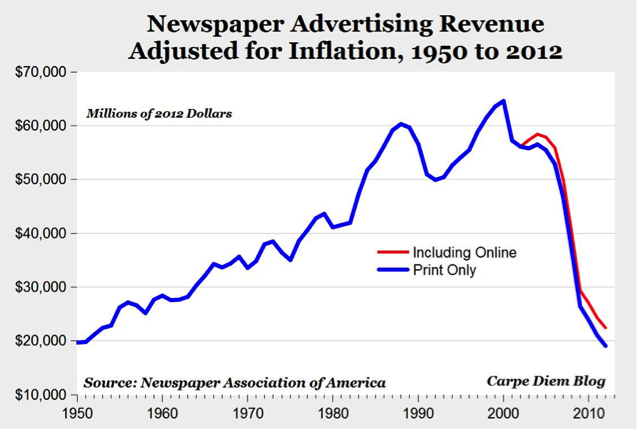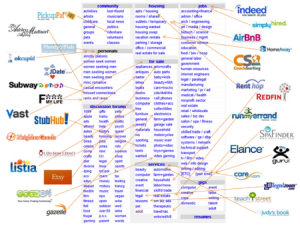Advertising Service Disruption
 I wrote this post in 2013. it is…. still relevant. If not more so.
I wrote this post in 2013. it is…. still relevant. If not more so.
“If you dislike change, you’re going to dislike irrelevance even more.” – General Eric Shinseki
In 1995 I moved from Saatchi & Saatchi Advertising Worldwide to launch New Jersey Online for Advance Publications. It was exciting to play a role in the burgeoning online news industry. It was also scary to know that the daily newspaper was about to be disrupted by the Internet. We had a sense of what was coming and created new online approaches to deliver the news, new advertising formats and new services including well-trafficked community forums which were a harbinger of the coming power of social media.
What most in the newspaper industry didn’t see coming until it was too late was Craig Newmark. Craigslist started as a San Francisco event email service in 1995, moved to Web based delivery in 1996 and then expanded into other categories. Craigslist began to rollout across the world in 2000.
Craigslist and other online classified sites like HotJobs, Monster, Realtor.com and Cars.com radically disrupted the newspaper industry’s multi-billion dollar golden goose – classified ad sales. Some of you might not remember the huge amount of newsprint devoted to auto, jobs, real estate and for-sale classifieds in the late 1990’s. But, just imagine that the classifieds sections alone were at least as thick as today’s current dailies. Newspapers derived much of their cash from small classified ads, not from Macy’s display ads.
The decline of newspaper revenues from the loss of classified sales and the move to other forms of digital advertising and news delivery has been dramatic. I’ve keep this image large for effect.
Obviously newspapers are not the only business that’s being disrupted. Guess what, even Craigslist is getting hammered by newcomers.
Yikes!
(The chart might be clearer at Andrew Parker’s Gong Show.)
And, what about the advertising industry?
While I don’t think that the world of advertising agencies will experience the dramatic loss of industry relevance akin to newspapers (or travel agents), disruption is a daily occurrence that is affecting our bottom line. The billions spent via Google’s AdWords DIY services has to come from somewhere. That somewhere is the total pot of advertising dollars.
Even some analog businesses are disrupting the old advertising model. Talent agencies like CAA have morphed into marketing agencies with their CAA Marketing in-house agency winning a Cannes Grand Prix for their fantastic Chipotle TV commercial. But wait, there’s more. The barrage of disruption is growing daily.
- Agencies that are not really “agencies”: Conde Nast Studios and Radical Media, “A global transmedia company that develops and produces television shows, films, commercials, brand identities, advertising concepts, digital content and event-based entertainment.”
- DIY design: I keep seeing ads for 99 Designs. “The #1 marketplace for graphic design, including logo design, web design and other design contests. Over 150000 satisfied customers!”
- DIY ads: Google AdWords, LinkedIn, Facebook and Spotrunner
- Implementation: avVenta, “avVenta resources plug into existing marketing operations to help brands reduce operational costs by improving processes, global standards and outsourcing key responsibilities” and E-Graphics, “E-Graphics Worldwide blends global multichannel capabilities with in-house efficiencies, that adapts and extends your marketing message.”
- Ideas: Ideascicle, “It’s expert sourcing. Not crowdsourcing” and Genius Rocket and their pitch…
GeniusRocket is what an ad agency looks like when it’s stripped of Madison Avenue skyscrapers, high-priced creatives on payroll, sushi dinners at Nobu, and two-week shoots at the Viceroy in Santa Monica.
Is it time for advertising agencies to roll over and die? No.
But you may need to change your stay-the-course mindset – and soon. For starters, ask yourself if using yesterday’s business model is hindering your growth. Maybe staying the course seems sane to you but living by past decisions and worrying about sunk costs could make you red meat for disruption. But, that’s not how the digital community plays…
“If you’re not doing something crazy, you’re doing the wrong things.” – Google CEO Larry page
I recently read the results of a CIO Network task force on how major corporations deal with disruptive technology. The task force was co-chaired by CIO’s from Jet Blue, Nissan and Rio Tinto. These CIO’s offer some relevant advice to avoid irrelevance.
Here are a couple of their recommendations plus some of my thoughts and ideas related to the advertising industry.
1. CREATING A CULTURE
“CIOs should create a cultural appetite that accepts change, risks and failure, and understands that innovation can take time. Invite venture capitalists and entrepreneurs to talk to senior leadership and identify ways your business is going to be disrupted.”
My Plan:
Accept and embrace the idea that change is good.
Take some of your agency time to do a SWOT analysis to identify and begin to address change-driven Threats and Weakness that could impede your agency’s future. In the world of disruptive technology, the future is next month not next year.
Get out of the office and meet with start-ups and young, hungry technologists. Go to tech events. Trade your services and experience for start-up insights and energy. Here is a blog post I wrote on AdPulp about the importance of getting out of the office. Religiously reading AdWeek in the comfort of your office will not grow your agency.
2. PARTITION DISRUPTION
“Name the disruption and then partition it as a separate business with separate financials, people and metrics.”
My Plan:
Leverage the disruption by building a business around it. Think like a start-up. Is this a brand new idea? No. But, are you?
I had a chance in 2008 to be an early leader in the new Android applications market. It was a relatively low cost way to move my agency into mobile marketing. But, I seriously blew it.
When I learned that Google’s Android was going to launch an application SDK, I asked our Digital CD to accelerate the creation of a new business unit by buying a related URL (like, www.androiddeveloper.com; it was early); build out a lean lead-generation website to highlight our expertise (as in fake it to start) and run some Google ads to gauge early market interest to see if we could generate incoming leads. All of this was designed to make us look like we had our act together while we were going out into the Portland mobile developer community to find partners. Unfortunately, the CD didn’t share my need for speed and he dragged his feet until we missed the early-stage window of opportunity.
I learned three things.
- Starting a new division or operating unit on the back of a disruptive technology is a good idea.
- Just do it. Be quick to prototype, test, iterate and launch especially if it can be a low-cost entry. When pundits say that agencies should act like start-ups this is what they mean.
- Hire the right people who share your energy and bias for action. The wrong people could kill your future. The Digital CD left a couple of months later.
To see a company that actually lives and leverages disruption, take a look at New York’s The Mobile Media Lab. They embrace visual technologies like Instagram and Pinterest as brand new marketing services that are getting major client attention.
3. KEEP HEAD OUT OF SAND
“Identify and accept inevitabilities and work them into your strategy. Create an unassailable argument around the inevitable to gain acceptance in the organization.”
My Plan:
Create an innovation culture or maybe an innovation team. Benchmark companies like IDEO.
Help your people understand that without innovation you might have to close your doors; they could lose their jobs and even careers.
Build a system for continually identifying disruptive and opportunistic technologies and use scenario planning and estimated financials to help review business opportunities. You don’t have to completely change your business model. Maybe all you need to do is add a new marketable service. Something purple (as in Purple Cow.)
A last word.
One of my favorite clients was Legalzoom.com. Legalzoom.com is in the business of disrupting the legal industry. Disruption is cool if you are the one doing it. I’ve used Legalzoom.com for my wills, advance directives, power of attorneys and LLC formation. They easily curtailed my use of lawyers and, like my experience in online news, heightened my understanding of the dramatic power of digital disruption.
To demonstrate my agency’s understanding of the idea of disruption in our Legalzoom pitch, we used a photoshopped picture of a large yacht sitting on a trailer in downtown LA. The For Sale sign read… “Lawyer needs cash. Thank You Legalzoom.”
OK, one more last word.
I just did a search on me to see when I started to think hard about disruption. Here is a link to a 1996 AdAge article that included some of my thoughts on the subject: “Classifieds prove to be a goldmine for online outlets.”



business directory…
Advertising: Get Ahead Of Disruption. Or Else. – //dev Peter Levitan dev//…